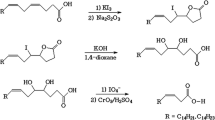Abstract
The cyclopropane fatty acids 17-methyl-trans-4,5-methyleneoctadecanoic acid, 18-methyl-trans-4,5-methylenenonadecanoic acid, and 17-methyl-trans-4,5-methylenenonadecanoic acid were characterized for the first time in nature in the phospholipids (mainly PE, PG and PS) of the hermit-crab sponge Pseudospongosorites suberitoides. Pyrrolidine derivatization was the key in identifying the position of the cyclopropyl and methyl groups in the acyl chains and 1H NMR was used to determine the trans stereochemistry of the cyclopropane ring. The phospholipids from the sponge also contained an interesting series of iso-anteiso Δ5,9 fatty acids with chain-lengths between 17 and 21 carbons, with the fatty acids (5Z,9Z)-18-methyl-5,9-nonadecadienoic acid and the (5Z,9Z)-17-methyl-5,9-nonadecadienoic acid being described for the first time in sponges. The anteiso α-methoxylated fatty acid 2-methoxy-12-methyltetradecanoic acid was also identified for the first time in nature in the phospholipids of this interesting marine sponge. The novel cyclopropyl fatty acids could have originated from the phospholipids of a cyanobacterium living in symbiosis with the sponge.
Similar content being viewed by others
Abbreviations
- ATCC:
-
American type culture collection
- ECL:
-
Equivalent chain length
- FAME:
-
Fatty acid methyl ester
- GC–MS:
-
Gas chromatography–mass spectrometry
- PE:
-
Phosphatidylethanolamine
- PG:
-
Phosphatidylglycerol
- PS:
-
Phosphatidylserine
References
Gunstone FD (1994) Cyclic acids, In: Gunstone FD, Harwood JL, Padley FB (eds) The lipid handbook, 2nd edn, Chapman and Hall, London, pp 13–14
Grogan DW, Cronan JE Jr (1997) Cyclopropane ring formation in membrane lipids of bacteria. Microbiol Mol Biol Rev 61:429–441
Cox AD, Wilkinson SG (1989) Polar lipids and fatty acids of Pseudomonas cepacia. Biochim Biophys Acta 1001:60–67
Holz GG Jr, Beach DH, Singh BN, Fish WR (1983) Biosynthesis of the novel fatty acid, 17-methyl-cis-9,10-methyleneoctadecanoic acid, by the parasitic protozoan Herpetomonas megaseliae. Lipids 18:607–610
Saito T, Ochiai H (1998) Fatty acid composition of the cellular slime mold Polysphondylium pallidum. Lipids 33:327–332
Gontier E, Boussouel N, Terrasse C, Jannoyer M, Menard M, Thomasset B, Bourgaud F (2000) Litchi chinensis fatty acid diversity: occurrence of the unusual cyclopropanoic fatty acids. Biochem Soc Trans 28:578–580
Fish WR, Holz GG Jr, Beach DH, Owen E, Anekwe GE (1981) The cyclopropane fatty acid of trypanosomatids. Mol Biochem Parasitol 3:103–115
Lankelma J, Ayanoglu E, Djerassi C (1983) Double-bond location in long-chain polyunsaturated fatty acids by chemical ionization-mass spectrometry. Lipids 18:853–858
Nemoto T, Yoshino G, Ojika M, Sakagami Y (1997) Amphimic acids and related long-chain fatty acids as DNA Topoisomerase I inhibitors from an Australian sponge, Amphimedon sp.; isolation, structure, synthesis, and biological evaluation. Tetrahedron 53:16699–16710
MacMillan JB, Molinski TF (2005) Majusculoic acid, a brominated cyclopropyl fatty acid from a marine cyanobacterial mat assemblage. J Nat Prod 68:604–606
Diaz MC, Pomponi SA, Van Soest RWM (1993) A systematic revision of the Central West Atlantic Halichondrida (Demospongiae, Porifera). Part III: description of valid species. Sci Mar 57:283–306
Sitachitta N, Gerwick WH (1998) Grenadadiene and grenadamide, cyclopropyl-containing fatty acid metabolites from the marine Cyanobacterium Lyngbya majuscula. J Nat Prod 61:681–684
Privett OS, Dougherty KA, Erdahl WL, Stolyhwo A (1973) Lipid composition of developing soybeans. J Am Oil Chem Soc 50:516–520
Carballeira NM, Alicea J (2001) The first naturally occurring α-methoxylated branched-chain fatty acids from the phospholipids of Amphimedon complanata. Lipids 36:83–87
Djerassi C, Lam WK (1991) Sponge Phospholipids. Acc Chem Res 24:69–75
Carballeira NM, Maldonado ME, Rivera E, Porras B (1989) The fatty acid 4,8,12-trimethyltridecanoic as a common constituent of the phospholipids of the sponge families Spirastrellidae and Clionidae. Biochem Syst Ecol 17:311–314
Andersson BA (1978) Mass spectrometry of fatty acid pyrrolidides. Prog Chem Fats Lipids 16:279–308
Knothe G (2006) NMR characterization of dihydrosterculic acid and its methyl ester. Lipids 41:393–396
Carballeira NM, Alicea J (2002) Novel methoxylated FA from the Caribbean sponge Spheciospongia cuspidifera, Lipids 37:305–308
Carballeira NM, Cruz H, Kwong CD, Wan B, Franzblau S (2004) 2-Methoxylated fatty acids in marine sponges: defense mechanism against Mycobacteria? Lipids 39:675–680
Bergquist PR, Lawson MP, Lavis A, Cambie RC (1984) Fatty acid composition and the classification of the Porifera. Biochem Syst Ecol 12:63–84
Walkup RD, Jamieson GC, Ratcliff MR, Djerassi C (1981) Phospholipid studies of marine organisms: 2. Phospholipids, Phospholipid-bound fatty acids and free sterols of the sponge Aplysina fistularis (Pallas) forma fulva (Pallas) (=Verongia thiona). Isolation and structure elucidation of unprecedented branched fatty acids Lipids 16:631–646
Thiel V, Blumenberg M, Hefter J, Pape T, Pomponi SA, Reed J, Reitner J, Wörheide G, Michaelis W (2002) A chemical view of the most ancient metazoa-biomarker chemotaxonomy of hexactinellid sponges. Naturwissenschaften 89:60–66
Hartmann S, Minnikin DE, Römming HJ, Baird MS, Ratledge C, Wheeler PR (1994) Synthesis of Methyl 3-(2-octadecylcyclopropen-1-yl)propanoate and methyl 3-(2-Octadecylcyclopropen-1-yl)pentanoate and cyclopropane fatty acids as possible inhibitors of mycolic acid biosynthesis. Chem Phys Lipids 71:99–108
Acknowledgments
This work was supported by a grant from the SCORE program of the National Institutes of Health (grant no. S06GM08102). J. Vicente thanks the NIH-MARC program for an undergraduate fellowship.
Author information
Authors and Affiliations
Corresponding author
About this article
Cite this article
Carballeira, N.M., Montano, N., Vicente, J. et al. Novel Cyclopropane Fatty Acids from the Phospholipids of the Caribbean Sponge Pseudospongosorites suberitoides . Lipids 42, 519–524 (2007). https://doi.org/10.1007/s11745-007-3047-3
Received:
Accepted:
Published:
Issue Date:
DOI: https://doi.org/10.1007/s11745-007-3047-3



